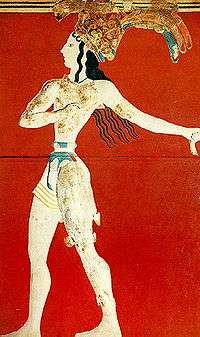Prince of the Lilies
 | |
| Year | circa 1550 BC |
|---|---|
| Location | Heraklion Archaeological Museum |
The Prince of the Lilies, or the Lily prince, is a celebrated Minoan fresco on the Greek island of Crete; the fresco is dated to circa 1550 BC (the new palace period between 1700 and 1450 BC).
The Minoan Frescoes
Fresco painting was one of the most important forms of Minoan art. Unfortunately, many of the surviving examples are fragmentary. The walls of the great halls of the palaces and houses of Crete were skilfully decorated with frescoes. The paint was applied swiftly while the wall plaster was still wet, so that the colours would be completely absorbed and would not fade. The Minoans followed the Egyptian convention regarding colours (e.g. red for men's flesh, white for women's flesh, yellow for gold, blue for silver, and red for bronze). Through the frescoes, one can gain the sense of the character of Minoan life and art and the Minoan joie de vivre.[1] Some frescoes were reconstructed between 1450 and 1400 BC, when the Myceneans had established themselves on the island, and exhibit a completely different style of art.[2]
Location
A copy of the painting is placed at the Procession Fresco, a long passageway known as the Corridor of the Procession at the palace of Knossos, while the original is on display at the Heraklion Archaeological Museum. It shows a young man strolling in a garden. He wears a short apron, which was incorrectly added by archaeologist Arthur Evans,[3] a necklace of lilies, a crown of lilies and peacock feathers. He is thought to represent the Priest King of Knossos. Possibly he has a griffin or a sphinx on a leash in his left hand. His skin is painted white, which was normally reserved for depicting women.
Reconstitution
The reconstitution of the so-called "Priest-king" from Knossos is one of the more popular figures of minoan art. It is made with three ancient fragments of painted plaster (the crown, the torso, the left leg); the other parts are modern, hypothetic painting. When Arthur Evans uncovered the plaster fragments in 1901, he wrote that they belonged to different personages and "the torso may suggest a boxer".[4]
Anatomical observation of this torso shows a contracted powerful musculature and the left disappeared arm was surely in ascendant position because the pectoral muscle is raised. These observations allow us to conclude the torso was one of a boxer resembling the many athletic representations engraved on the Boxer Vase from Hagia Triada. The lily crown belonged to another personage, perhaps a priestess (like on Hagia Triada sarcophagus). The painted reliefs of two athletes boxing in the palace of Knossos were surely the model of the "boxing children" fresco in Akrotiri at Thera.[5]
Trivia
A stylized version of the fresco is the official logo of the Greek ferry company Minoan Lines.
See also
- List of Aegean frescos
- Minoan civilization
- Akrotiri
- Ancient Greek boxing
- La Parisienne (fresco)
- Bull-Leaping Fresco
References
- ↑ J.A. Sakellarakis. Herakleion Museum. Illustrated guide to the Museum Ekdotike Athinon, Athens 1987, p. 118
- ↑ Furumark
- ↑ F. Schachermeyer. Die Minoische Kultur des alten Kreta
- ↑ Arthur Evans published his findings in the Annual of the British School at Athens BSA 7 (1900-1901) p. 15–16.
- ↑ Ancient Greek boxing: Origins
Bibliography
- A. Evans, The Palace of Minos at Knossos Book 1 page 8, 272
- S. Hood, The Minoans (1971) image 43
- Sp. Marinatos Excavations at Thera IV (1971) p. 47-49
External links
- Greek thesaurus - Minoan civilization
- Kathimerini newspaper - 7 days
- Herakleion Archaeological Museum